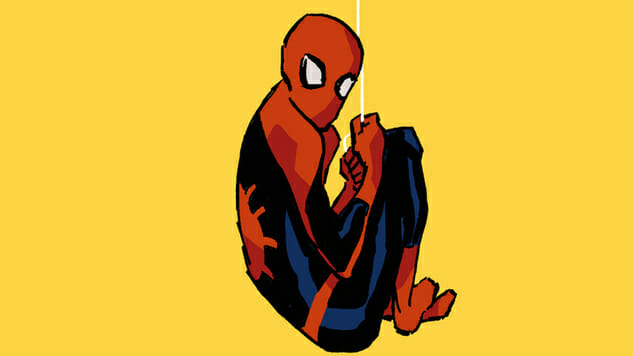So You Loved Spider-Man: Homecoming? Read These Comics Next
From Tom Holland & Michael Keaton to Brian Michael Bendis & Hannah Blumenreich
Main Art by Hannah Blumenreich
Spider-Man: Homecoming swung into theaters this past weekend and the response has been near-unanimous: despite five previous films across two now-defunct continuities, this is Spider-Man. Thanks to a strong cast full of standout performances (Zendaya!), perfect casting in the form of Tom Holland and Michael Keaton and a seamless assimilation into the Marvel Cinematic Universe, Homecoming stands out not just as a superior wallcrawler film, but as a highlight of the MCU’s ever-expanding bounty of film outings. Diving into Peter Parker’s comic history can be a daunting task, though: nearly every era has standout stories, and Parker’s exploits are among Marvel’s most frequently double- and triple-shipped comics, adding up to over 700 issues of his main series, let alone long-running titles like Ultimate Spider-Man. The webheads here at Paste took a crack at narrowing down 10 suggested stories for fans of Homecoming, although we could just as easily have suggested the near-entirety of the aforementioned Ultimate Spider-Man, which served as a major inspiration on Homecoming’s high-school setting. There are major Spidey touchstones missing from this list—”The Death of Jean DeWolff” and “The Kid Who Collects Spider-Man,” sob—but we curated with an eye toward accessibility and matching the magic that made Homecoming work so well. Be sure to let us know on Twitter if we missed any essential arachnid tales.
 “If This Be My Destiny,” The Amazing Spider-Man
“If This Be My Destiny,” The Amazing Spider-Man
Writers: Stan Lee, Steve Ditko
Artist: Steve Ditko
Spider-Man co-creator Steve Ditko immortalized the soul of his landmark superhero through this powerful cover released in February 1966. This image is Spider-Man. The concluding chapter of the three-issue “If This Be My Destiny” arc trapped Peter Parker in a flooded underwater hideout, a latticework of steel pinning him down as he loses consciousness. The image immaculately captures an underdog icon struggling to uphold the weight of the world on his back—guilt, responsibility and teenage hormones substantiated into a collapsing industrial clusterfuck. (And Homecoming director Jon Watts evidently felt the same way, given the film’s direct homage.) Stan Lee and Ditko’s narrative also provides a thematic bookend to the character’s first appearance in Amazing Fantasy #15, with Parker striving to cure his Aunt May of radioactive poisoning. With the ghostly words of Uncle Ben haunting him, Spidey infiltrates Doctor Octopus’ lair, kicks some ass and embraces his inner Atlas to deliver a remedy to Dr. Kurt Conners—saving his last family member and staving off the Parker curse. Stirring story aside, this imagery serves as some of the most iconic eye candy for the superhero genre, and a bittersweet reminder of how relatively short and sweet Ditko’s contribution to the medium was. Sean Edgar
 “Kraven’s Last Hunt,” The Amazing Spider-Man, Web of Spider-Man, The Spectacular Spider-Man
“Kraven’s Last Hunt,” The Amazing Spider-Man, Web of Spider-Man, The Spectacular Spider-Man
Writers: J.M. DeMatteis, Peter David, David Michelinie, James Owsley
Artists: Mike Zeck, Mark Beachum, Mark Bright, Steve Geiger, John Romita, Jr.
The grim comics era ignited by Watchmen and The Dark Knight Returns stained Peter Parker’s vibrant myth in this 1987 arc helmed by J.M. DeMatteis. It’s also a cutting character dissection of the men and women who put on ridiculous costumes to reign terror on the public. The six-issue story ran through all three of Spider-Man’s ongoing titles at the time, and starred the Russian hunter Kraven tranquilizing Spidey, burying him alive and impersonating the hero for the remainder of the tale. And he’s pretty good—if brutally efficient—at the job, taking down foes with ease that Peter Parker struggled to defeat. This story occupies a slot in the webbed archives, though, because of its harrowing ending, which witnesses Kraven ending his life after achieving a sense of accomplishment from conquering his foe through subversively patronizing methods. That finale invited a bizarre cognitive dissonance uncommon for the happy endings that frequent most superhero yarns. Do most villains suffer from superhero envy? Should they be given hugs instead of concussions? And damn, Marvel, suicide via shotgun for a character created by Lee and Ditko in ’64—only two years into the Spider-Mythos? And how does that tragic belittling affect the psyche of a hero constantly doubting his self-worth? Never answered, these questions still surround this haunting outlier. Sean Edgar
 “No One Dies,” The Amazing Spider-Man
“No One Dies,” The Amazing Spider-Man
Writer: Dan Slott
Artist: Marcos Martin
Spoiler alert, but Homecoming wisely opts to avoid hampering Tom Holland’s first full Spider-Man outing with any character deaths—no Uncle Ben redux, no love interest gone before her time, no ally caught in the crossfire. While it was a welcome break from the pathos of previous films, tragedy is a core component of the character, shaped as he is around the preventable death of a loved one. In this two-issue arc, the murder of longtime supporting character J. Jonah Jameson’s wife, Marla, prompts a nightmare in which Peter confronts everyone who has died “on his watch,” from Gwen Stacy to more easily forgotten characters like Frederick Foswell, in a stunning sequence illustrated by Private Eye’s Marcos Martin. Longtime Amazing Spider-Man writer Dan Slott uses this opportunity to double down on the sense of responsibility—and guilt—that drives Parker to continue his heroic tenure, but it’s Martin’s emotional dreamscapes that make this such a gorgeous example of the tragedy behind Spider-Man. Steve Foxe
-

-

-

-

-

-

-

-

-

-

-

-

-

-

-

-

-

-

-

-

-

-

-

-

-

-

-

-

-

-

-

-

-

-

-

-

-

-

-

-















































